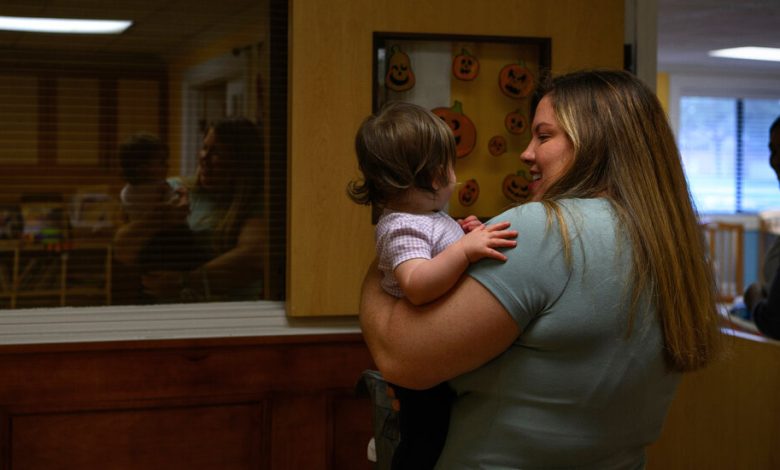The ‘Silver Lining to the Pandemic’ for Working Mothers

A larger share of American women is working for pay than at any point in history. According to a recent analysis, the surge has been led by an unexpected group: mothers of children under 5.
Though mothers in this group have always worked less than other women, their gains since the pandemic have been biggest. The analysis, by the Hamilton Project at the Brookings Institution and based on Bureau of Labor Statistics data, identifies a major reason: the newfound ability of certain mothers, especially those who are married with college degrees, to work remotely.
“What’s happening with married, well-educated women with young kids is crazy,” said Lauren Bauer, a fellow at Brookings and an author, with Sarah Yu Wang, of the analysis. “These are women who see themselves as workers. They were on the upward trend before the pandemic and they bounced back and just kept going.”
Julia Keintz took a job leading analytics at Zillow two years ago, when her children were 6 months and 11. One of the reasons she wanted the job, she said, was that since the pandemic, Zillow has allowed employees to live where they want and work flexible schedules.
She lives outside San Francisco, where Zillow has an office, but she rarely goes in. When her youngest was a baby, she could avoid lugging breast milk pumping supplies to and from work. She saves 90 minutes a day by not commuting. She can give her older child an after-school snack and drive him to sports practices and bar mitzvah preparations.
In previous jobs, she said, she felt that she had to figure out how to juggle work and parenting on her own, and that she might have to quit if she couldn’t. “It always felt like a secret, like I was an exception,” Ms. Keintz said. “Zillow is the first company I worked for where flexibility is an outwardly stated thing.”
The share of women working in the United States increased rapidly starting in the 1970s, with the women’s movement. For those ages 25 to 54, it surpassed 77 percent in the 1990s, when changes in welfare and the earned-income tax credit pushed more women into work. But then it stalled, even as it continued increasing in peer countries. Economists have attributed this to the lack of family-friendly policies in the United States, like paid leave and subsidized child care. Also, employers increasingly expect round-the-clock availability, a challenge with children at home.
Labor force participation for all working-age adults, including mothers, increased in late 2019, just before the pandemic, when a combination of very low unemployment and certain state and local policies eased the path to finding a job.
Today, 77.7 percent of women 25 to 54 are employed, a new high, and proof that pandemic school and child care closures failed to erase decades of gains in women’s employment. Larger shares of mothers of both preschool and school-age children are working now than just before the pandemic.
Several factors have brought more women into the work force in recent months. There were temporary federal expansions of paid leave and child care subsidies during the pandemic, and some states and cities have made similar benefits permanent. A tight labor market has probably contributed, by making jobs more attractive, as has inflation, by making a higher income more essential. And cultural shifts that started prepandemic have continued — women are getting more education and having children later, and investing more of their time and identity in a career.
Yet a particularly influential change for parents, researchers say, has been remote work for people with office jobs, and more flexibility on when and where work gets done. These pandemic-driven changes are benefiting other groups too, like people with disabilities, who are also working at record levels.
Becca Cosani took a new job as a health insurance consultant when her oldest daughter, Emilia, now 3, was a baby. She called it a “scary move” because of the constant travel that consulting requires, with a baby and a husband whose business, engine rebuilding, can’t be run from home.
“Women are working more because they have to,” she said. “Our day care costs more than our mortgage. I’m a high earner and I look for coupons for my groceries.”
Then the pandemic hit, and the travel never materialized, because clients were working remotely and decided it was more efficient. She works from her home office, in Missouri City, Texas.
On breaks, she does laundry or runs errands. “That time is gifted back to me in time I can spend with my kids when they’re home,” she said of activities like riding bikes or searching for pecans from their backyard tree. When one of them has an ear infection or an after-school ballet class, she can duck out.
She walks Emilia and Isabel, 1, home from preschool each day. They take it slow, stopping to look at the leaves, something she said she would have missed if she were commuting or traveling: “It is just the joy of my life to be able to do that.”
The analysis did not include fathers, but other data suggests that those who can work from home are also spending more time parenting than before the pandemic, and value flexibility more than they once did.
“The ‘new normal at work’ is at work here,” said Claudia Goldin, a Harvard economist who won the Nobel Prize this month for her research on female employment. Some women who would have stopped working when their children were young have not, she has found: “It is the great silver lining to the pandemic.”
Mothers of babies and toddlers, an age group that requires significant hands-on care, have benefited most from remote work, the Hamilton Project analysis shows. Of college-educated mothers of children under 5, 80.3 percent are working, up from a previous high of 77.4 percent at the end of 2019. Nearly half of them said in federal surveys that they worked from home at least once a week, a much larger share than any other group.
Women with less education, and those who are Hispanic or unmarried, are more likely to have a job that can’t be done remotely, like retail clerk or health aide. Though this group has largely returned to work, they are still working below the rate they were before the pandemic: Of mothers with young children and a high school diploma or less, 54.4 percent are working, compared with 56.1 percent in late 2019.
These workers are also least likely to have employers that provide other kinds of family-friendly benefits, or a spouse with flexible hours. Government policies, researchers say, would be necessary to reach all workers.
“Women who can’t work remotely, that needs special attention,” said Misty Heggeness, an economist at the University of Kansas. “If anything good can come out of our awareness and understanding of that, it’s how can we build better social policies and social and structural supports.”
Graphics by Francesca Paris.




